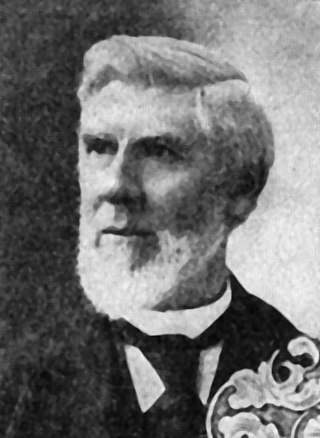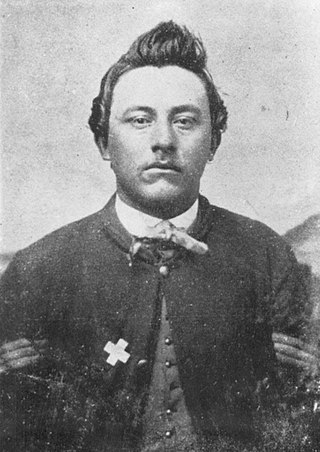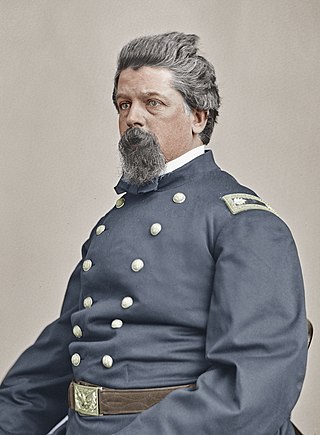The Army of the Shenandoah was a field army of the Union Army active during the American Civil War. First organized as the Department of the Shenandoah in 1861 and then disbanded in early 1862, the army became most effective after its recreation on August 1, 1864 under the command of Philip Sheridan. The army's actions during the Valley campaigns of 1864 rendered the Shenandoah Valley of Virginia unable to produce foodstuffs for the Confederate States Army, a condition which would hasten the conclusion of the American Civil War.
The Army of West Virginia served in the Union Army during the American Civil War and was the primary field army of the Department of West Virginia. It campaigned primarily in West Virginia, Southwest Virginia and in the Shenandoah Valley. It is noted for having two future U.S. presidents serve in its ranks: Rutherford B. Hayes and William McKinley, both from the 23rd Ohio Infantry. With fighting in the Valley ended, the Army of West Virginia's designation was discontinued.

The 5th Infantry Regiment is an infantry regiment of the United States Army that traces its origins to 1808.

Eri Davidson Woodbury was a Union Army officer during the American Civil War. He received the Medal of Honor for gallantry during the Battle of Cedar Creek fought near Middletown, Virginia on October 19, 1864. The battle was the decisive engagement of Major General Philip Sheridan’s Valley Campaigns of 1864 and was the largest battle fought in the Shenandoah Valley.

James Sweeney was a Union Army soldier during the American Civil War. He received the Medal of Honor for gallantry during the Battle of Cedar Creek fought near Middletown, Virginia on October 19, 1864. The battle was the decisive engagement of Major General Philip Sheridan's Valley Campaigns of 1864 and was the largest battle fought in the Shenandoah Valley.

Andrew Jackson McGonnigle was a Union Army officer during the American Civil War. He received the Medal of Honor for gallantry during the Battle of Cedar Creek fought near Middletown, Virginia on October 19, 1864. The battle was the decisive engagement of Major General Philip Sheridan's Valley Campaigns of 1864 and was the largest battle fought in the Shenandoah Valley.

John W. Blunt was a Union Army officer during the American Civil War. He received the Medal of Honor for gallantry during the Battle of Cedar Creek fought near Middletown, Virginia on October 19, 1864. The battle was the decisive engagement of Major General Philip Sheridan's Valley Campaigns of 1864 and was the largest battle fought in the Shenandoah Valley.

Henry H. Crocker was a Union Army officer during the American Civil War. He received the Medal of Honor for gallantry during the Battle of Cedar Creek fought near Middletown, Virginia on October 19, 1864. The battle was the decisive engagement of Major General Philip Sheridan's Valley Campaigns of 1864 and was the largest battle fought in the Shenandoah Valley.

David H. Scofield was a Union Army soldier during the American Civil War. He received the Medal of Honor for gallantry during the Battle of Cedar Creek fought near Middletown, Virginia on October 19, 1864. The battle was the decisive engagement of Major General Philip Sheridan’s Valley Campaigns of 1864 and was the largest battle fought in the Shenandoah Valley.

Ulric Lyona Crocker was a Union Army soldier during the American Civil War. He received the Medal of Honor for gallantry during the Battle of Cedar Creek fought near Middletown, Virginia on October 19, 1864. The battle was the decisive engagement of Major General Philip Sheridan's Valley Campaigns of 1864 and was the largest battle fought in the Shenandoah Valley.

Ira Hough was a Union Army soldier during the American Civil War. He received the Medal of Honor for gallantry when he captured an enemy flag during the Battle of Cedar Creek fought near Middletown, Virginia on October 19, 1864. The battle was the decisive engagement of Major General Philip Sheridan's Valley Campaigns of 1864 and was the largest battle fought in the Shenandoah Valley.

Daniel P. Reigle was a Union Army soldier during the American Civil War. He received the Medal of Honor for gallantry during the Battle of Cedar Creek fought near Middletown, Virginia on October 19, 1864. The battle was the decisive engagement of Major General Philip Sheridan’s Valley Campaigns of 1864 and was the largest battle fought in the Shenandoah Valley.

Thomas McCoy Wells was an Irish born Union Army soldier and officer during the American Civil War. He received the Medal of Honor for gallantry during the Battle of Cedar Creek fought near Middletown, Virginia on October 19, 1864. The battle was the decisive engagement of Major General Philip Sheridan's Valley Campaigns of 1864 and was the largest battle fought in the Shenandoah Valley.

Richard Taylor was a Union Army soldier during the American Civil War. He received the Medal of Honor for gallantry during the Battle of Cedar Creek fought near Middletown, Virginia on October 19, 1864. The battle was the decisive engagement of Major General Philip Sheridan's Valley Campaigns of 1864 and was the largest battle fought in the Shenandoah Valley.

John Walsh was an Irish-born Union Army soldier during the American Civil War. He received the Medal of Honor for gallantry during the Battle of Cedar Creek, fought near Middletown, Virginia on October 19, 1864. The battle was the decisive engagement of Major General Philip Sheridan's Valley Campaigns of 1864 and was the largest battle fought in the Shenandoah Valley.

Martin Wambsgan was a German born Union Army soldier during the American Civil War. He received the Medal of Honor for gallantry during the Battle of Cedar Creek fought near Middletown, Virginia on October 19, 1864. The battle was the decisive engagement of Major General Philip Sheridan's Valley Campaigns of 1864 and was the largest battle fought in the Shenandoah Valley.

Edwin Goodrich was a Union Army officer during the American Civil War.

The 14th Louisiana Infantry Regiment was a unit of volunteers recruited in Louisiana that fought in the Confederate States Army during the American Civil War. Formed in June 1861 as the 1st Regiment, Polish Brigade, the unit was later accepted into Confederate service as the 13th Regiment. After being sent to fight in the Eastern Theater of the American Civil War, it was renamed the 14th Regiment. In 1862, it fought at Yorktown, Williamsburg, Seven Pines, Beaver Dam Creek, Gaines' Mill and Glendale. At Glendale, the unit suffered a severe number of casualties and, thereafter, surviving members of the regiment dubbed the battle "the Slaughterhouse."

The 15th Louisiana Infantry Regiment was a unit of volunteers recruited in Louisiana that fought in the Confederate States Army during the American Civil War. Formed in June 1861 as the 2nd Regiment, Polish Brigade, the unit was sent to fight in the Eastern Theater of the American Civil War. As the 3rd Louisiana Infantry Battalion, the unit served at Beaver Dam Creek and Glendale. After two companies from the 7th Louisiana Infantry Battalion were added in July 1862, the unit reorganized as the 15th Louisiana Infantry Regiment. It joined the 2nd Louisiana Brigade and fought at Cedar Mountain, Second Bull Run, Antietam, and Fredericksburg in 1862. It served at Chancellorsville, Second Winchester, Gettysburg, and Mine Run in 1863. The regiment fought at the Wilderness, Spotsylvania, Cold Harbor, Monocacy, Third Winchester, Fisher's Hill, Cedar Creek, and Petersburg in 1864. A handful of survivors surrendered at Appomattox in 1865.









